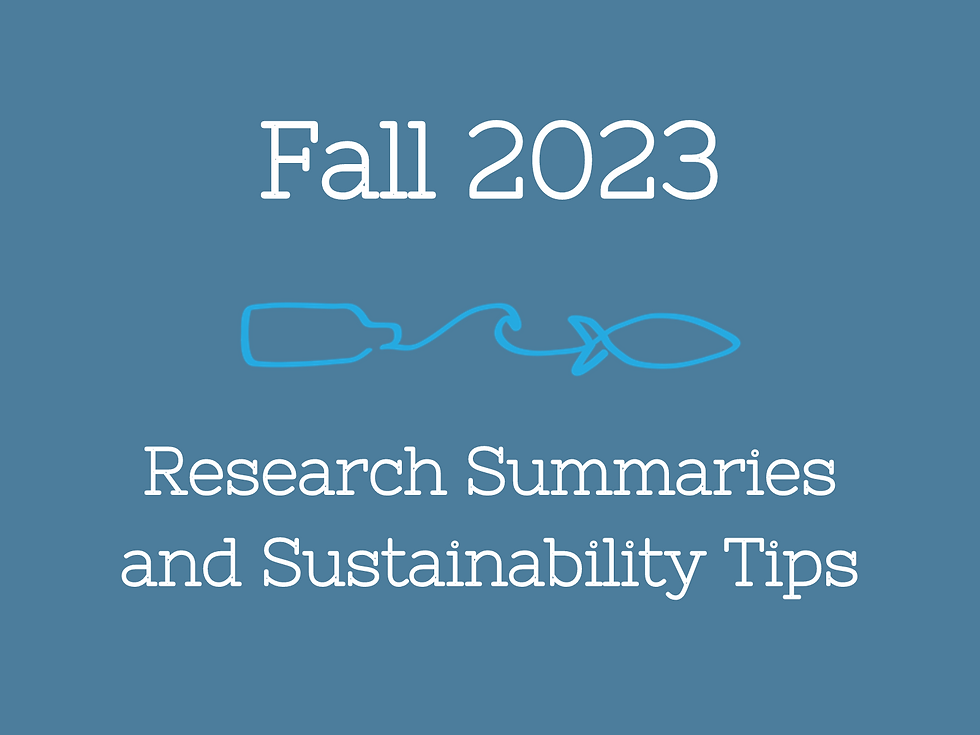Fall 2023 Research Summaries and Sustainability Tips
- keeptheoceaneverblue
- Dec 15, 2023
- 4 min read
A round-up of all our research summaries and sustainability tips from Fall 2023!

SEPTEMBER 7: RESEARCH SUMMARY - CORAL ALERTS
This summer, Florida has been experiencing one of its most widespread coral bleaching events ever.
According to a NOAA briefing held in August on the state of coral bleaching in Florida, we do not know the extent to which the reef will be permanently affected by this bleaching event. Bleached corals can recover if water temperatures cool back down, and as of right now, the NOAA Coral Reef Watch program has downgraded the Florida Keys from a bleaching Alert Level 2 earlier this summer (the most severe alert that signifies bleaching and significant mortality is likely) to bleaching Watch, since further bleaching is less likely as we move into fall and temperatures cool down.
To assess the full damage done by this summer’s bleaching in Florida, the NOAA Disturbance Response Monitoring program will send researchers to reefs throughout Florida to collect data on whether the bleached corals were able to recover or not. We at Everblue will keep an eye out for further reports and research coming out of this work to keep you aware of how the reefs in Florida are recovering. For now, you can help by sharing this video with your friends, family, and followers to raise awareness about what is happening underwater in Florida this summer.
RESEARCH: NOAA Deep Dive: Florida Coral Reef Bleaching Event briefing. August 17, 2023.
SEPTEMBER 8: SUSTAINABILITY TIP - ADVOCATE FOR REEFS
Reefs need our help to withstand, recover from, and build resilience against coral bleaching events. The widespread bleaching in Florida this summer is a jarring reminder of the threats our reefs face due to climate change caused by human overuse of fossil fuels. We know our reefs will continue to experience bleaching in the future due to current levels of ocean warming, so we need to advocate for them.
To preserve coral reefs into the future, we need to protect areas that are healthy and diverse, restore areas that are degraded, and dramatically decrease our use of fossil fuels. You can help by sharing Everblue’s posts on coral bleaching to raise awareness of the issue, talking to your local representatives about divesting from fossil fuel use, and supporting reef restoration efforts. If you want to support restoration in Florida, you can follow @coralrestorationfoundation to see updates on surveys and response efforts after the bleaching event.
NOVEMBER 2: RESEARCH SUMMARY - GLOWING IN THE DARK
Bioluminescence is light that is produced by a chemical reaction in living organisms. Although a few land species can bioluminesce (like fireflies!), most bioluminescent organisms are found in the ocean and include anything from fish, bacteria, and jellies. There are almost no bioluminescent organisms native to freshwater though!
Most bioluminescence, regardless of what organism it is, uses a very similar chemical reaction (luciferin and luciferase/photoproteins for you chemists! The different colors shown in different organisms are caused by the arrangement of these molecules, although most marine organisms express a blue-green color. But why do creatures do this?
Well, it can be for a lot of reasons! It can be used to hunt prey, distract and defend against predators, find mates, and other things! Most famously, the anglerfish has a little glowy ball (the esca) that attracts smaller fish to it so it can eat them. But organisms can also luminesce when they’re disturbed. Changes in the environment, such as a drop in salinity, or movement from a wave, can cause bioluminescent algae to glow. Enormous blooms of certain algae or bacteria can make the ocean glow at night!
RESEARCH: National Geographic
NOVEMBER 3: SUSTAINABILITY TIP - FIGHTING FIRES
This sustainability tip is going to be unrelated to bioluminescence, as efforts to help people impacted by the Maui fires still desperately need help. Please take a look at our post about how you can help some of those organizations.
NOVEMBER 15: RESEARCH SUMMARY - ONE THIRD
Globally, ⅓ of the food we produce is wasted every year. This is 1.3 billion tons of wasted food and is responsible for 3.3 billion tons of greenhouse gasses every year. Let’s conceptualize those numbers:
That is a loss of $1 Trillion per year. If we used this food responsibly, we could feed 2 billion people, which is more than twice the amount of people who are undernourished across the globe. And finally, if food waste was its own country, it would be the third greatest emitter, just behind the U.S. and China. As we seek better ways to prevent the worst case scenarios of climate change, we must confront our problem with food waste.
RESEARCH: Perspectives on food waste management: Prevention and social innovations. Al-Obadi et al. May 2022.
NOVEMBER 21: SUSTAINABILITY TIP - SHOP SMART
How can you reduce your food waste while still enjoying the holidays? Experts say the best way to reduce food waste is to shop smart. Plan how much food you will need and how much leftovers you would like to have. Then, after you’ve enjoyed your meal, offer to share leftovers with any friends or family members. This will save you money, reduce food waste and greenhouse gas emissions, and help brighten your loved ones’ day!








Comments